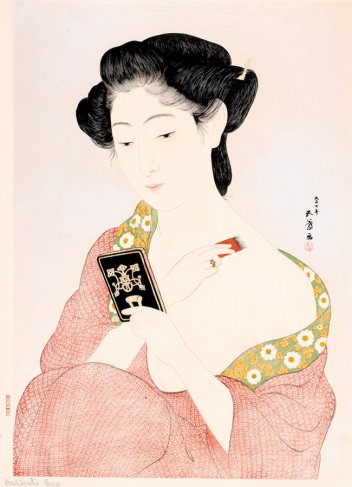Cultural Significance In Japanese Erotic Art
The word “erotic” instantly evokes layers of emotion ranging from fascinated to offended. But look beyond the knee-jerk reaction, and there’s plenty of cultural and historical significance in a show like “Modern Love: 20th-Century Japanese Erotic Art.” The exhibit is the third in a series of displays over the last couple years at Honolulu Museum of Art, following “Japanese Shunga” (17th and 18th century art) and “Tongue in Cheek” (19th century shunga). Co-curator of the exhibits and assistant curator of Japanese art Stephen Salel sat down with A&S for a scholarly view behind the erotic curtain:
Why look at shunga or sexually explicit Japanese art in the first place?
Starting with the first exhibition, “Arts of the Bedchamber: Japanese Shunga,” curator of Asian art Shawn Eichman and I focused on the origins of the genre. The exhibition didn’t merely focus on individual artists. We also needed to address topics like: What was the purpose of shunga? Who was its audience? And what were the general attitudes about sexuality that those artworks reflected? Those attitudes in 17th and 18th century Japan ― about gender, the sex industry and what sort of imagery and behavior was considered socially appropriate ― differed quite a lot from our own attitudes. We wanted visitors to consider those differences and to realize that sometimes our own attitudes cloud our judgment about the historical importance of the artwork.
What additional pertinent cultural topics come into play in an exhibit like this?
For more than 100 years, the Japanese government has banned the public display of erotic art. For people who value freedom of expression and freedom of the press, this reason alone makes a discussion of erotic art important. What’s interesting, however, is that the Japanese government only decided to ban erotic art because it was considered scandalous by the Americans and Europeans with whom they were interacting. The attitudes about sexuality by Westerners in the early 20th century have almost entirely erased what was once a thriving aspect of Japanese painting and printmaking from today’s art history textbooks.
Can you talk about the impact of World War II on Japanese erotic art?
Gen. MacArthur made great efforts to ensure the social rights of Japanese women. It’s interesting to note that more than half of the artists in this exhibition are women (in a traditionally males-only art form). Gender equality within Japan and opportunities for Japanese women to express themselves artistically have improved remarkably since the end of the Pacific war. This positive development, however, is balanced by other legacies of World War II. In the first two exhibitions, we discussed how erotic art reflects the commercial sex industry of that time, and one way in which the American occupation in fact damaged women’s rights was by fueling the sex industry through the creation of what was known as the Recreation and Amusement Association, which was a form of legalized prostitution.
How do the four mediums on display (printmaking, photography, manga and contemporary shunga in Japan and Hawaii) segue into each other?
At the beginning of the 20th century, traditional wood-block printmaking ― which we discussed in depth throughout the first two exhibitions about erotic art ― began to change and showed an ever increasing amount of influence from Western art. At the same time, photography was imported from the West. It quickly became popular and eventually eclipsed woodblock printmaking as a mode of artistic expression. In my opinion, manga (graphic novels) are in many ways a blend of these two media. Like woodblock prints, manga incorporate hand-drawn imagery that has traditional roots in woodblock prints, but they also rely heavily upon non-traditional technology like photography. Lastly, alongside the ways in which the outside world has crept into Japanese art, we discuss some Japanese artists who are living abroad, particularly those artists living in Hawaii.
Is Hawaii’s Japanese erotic art very different from Japan’s contemporary erotic art?
The work of Japanese artists who live in Hawaii and who produce art that deals with the topic of sexuality is closely linked to what artists based in Japan are doing. The prints of Masami Teraoka, for example, are strongly influenced by ukiyo-e (Japanese woodblock print) artists such as Katsushika Hokusai and Utagawa Kunisada. Mayumi Oda, another local artist, makes references to portraits of courtesans, which was a phenomenally popular subject in Japanese prints for centuries. Lastly, Yumiko Glover deals with depictions of youth and innocence, which also can be traced back to Japanese print artists. What is exciting about these local artists is that they are adding their own personal experiences and their political stances to the subjects they discuss.
What overall message do you want visitors of the exhibit to walk away with?
Like with the first two exhibitions, we want visitors to understand that erotic art is an important aspect of Japanese art history that should not be ignored or dismissed. We also want visitors to understand that the genre never ended. The use of the term shunga usually refers to erotic art produced during the 17th, 18th and 19th centuries. Nowadays, it’s considered anachronistic, but the art genre itself has never been livelier. This exhibition may be the conclusion to our museum’s exploration of Japan’s sexual culture, but the historical development of that art genre is far from over!
the TICKET stub
MODERN LOVE
When: Through March 15, 2015 (with lectures and films Dec. 3 and in February)
Where: Honolulu Museum of Art
Cost: $10 general admission
More Info: 532-8700, honolulumuseum.org






